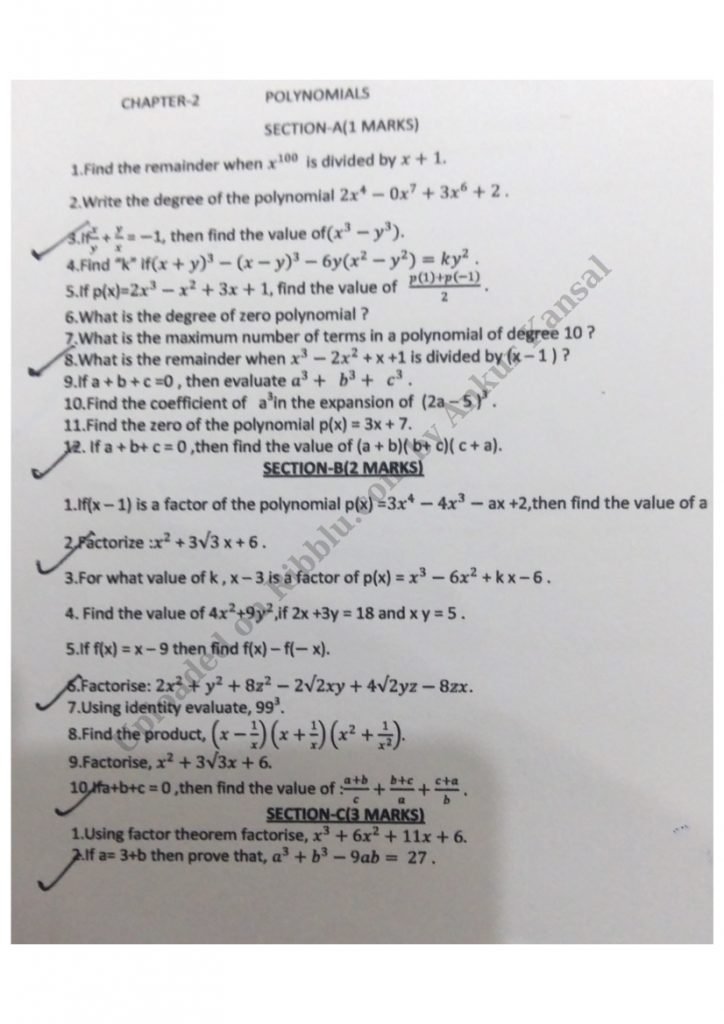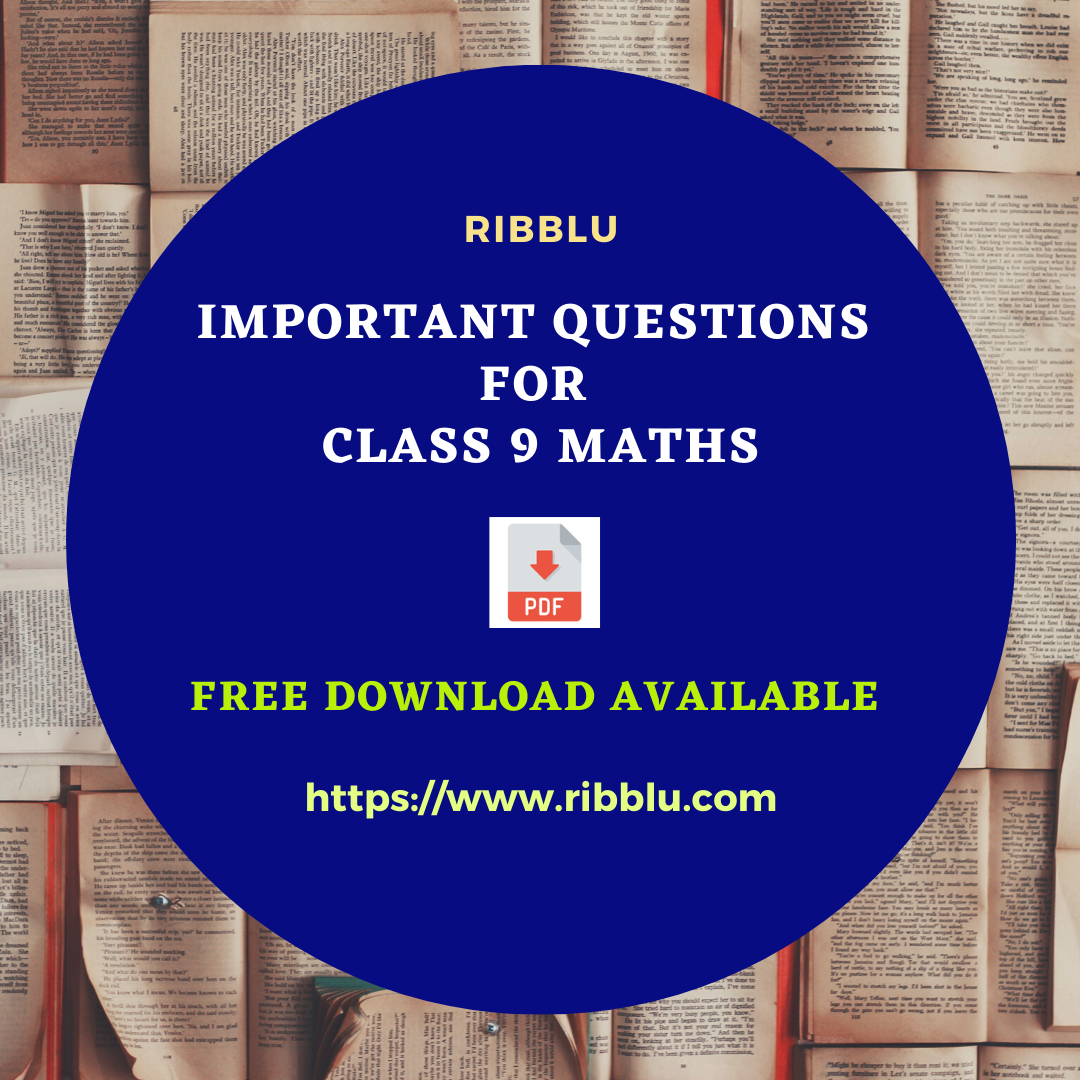CBSE Class 9 Maths Important questions are primarily a great tool that helps in scoring good marks in the class examinations as well as to prepare for the future board exams. These CBSE Chapter Wise Important Questions for Class 9 Maths 2019-20 in Pdf format have been shared and uploaded by various parents, students and school teachers who are registered users on ribblu. Here you may also find Solved NCERT Important Questions for Class 9 Maths with Solutions.
These CBSE Important Questions or Question bank chapter wise for Class 9th Maths gives students a very good idea about the type of questions that are likely to be asked in the board exams. Getting familiar with these will also help students to face the exams more confidently.
Chapter wise CBSE Important questions for Class 9th Maths:
Important Question Chapter 1 – Number System
Important Question Chapter 2 – Polynomial
Important Questions Chapter 3 – Coordinate Geometry
Important Questions Chapter 4 – Linear Equations in Two Variables
Important Questions Chapter 5 – Introduction to Euclid’s Geometry
Important Questions Chapter 6 – Lines and Angles
Important Questions Chapter 7 – Triangles
Important Questions Chapter 8 – Quadrilaterals
Important Questions Chapter 9 – Areas of Parallelograms
Important Questions Chapter 10 – Circles
Important Questions Chapter 11 – Constructions
Important Questions Chapter 12 – Heron’s Formula
Important Questions Chapter 13 – Surface Areas and Volumes
Important Questions Chapter 14 – Statistics
Important Questions Chapter 15 – Probability
Example Sample of Important Questions for Class 9 Maths

CBSE Class 9 Mathematics Test Papers
CBSE Class 9 Maths Previous Year Question Papers
CBSE Class 9 Maths Revision Notes
CBSE Sample Question Paper for Class 9 Maths
CBSE Worksheets for Class 9 Mathematics
Important Question of Other Classes
CBSE Important Questions of Class 12
CBSE Important Questions of Class 11
CBSE Important Questions of Class 10
CBSE Important Questions of Class 8
CBSE Important Questions of Class 7
CBSE Important Questions of Class 6
CBSE Important Questions of Class 4
CBSE Important Questions of Class 2
Chapter 1 : Real Numbers
Review of representation of natural numbers, integers and rational numbers on the number line. Representation of terminating / non-terminating recurring decimals on the number line through successive magnification. Rational numbers as recurring/ terminating decimals. Operations on real numbers.
Chapter 2 : Polynomials
Definition of a polynomial in one variable with examples and counter-examples. Coefficients of a polynomial, terms of a polynomial and zeros of polynomial. Degree of a polynomial. Constant, linear, quadratic and cubic polynomials. Monomials, binomials, trinomials. Factors and multiples. zeros of a polynomial. Motivate and State the Remainder Theorem with examples.
Chapter 3: Coordinate Geometry
The Cartesian plane, coordinates of a point, names and terms associated with the coordinate plane, notations, plotting points in the plane.
Chapter 4: Linear Equations in Two Variables
Recall of linear equations in one variable. Introduction to the equation in two variables. Focus on linear equations of the type ax + by + c = 0. Explain that a linear equation in two variables has infinitely many solutions and justify their being written as ordered pairs of real numbers, plotting them and showing that they lie on a line. Graph of linear equations in two variables.
Chapter 5 : Introduction to Euclid’s Geometry
History – Geometry in India and Euclid’s geometry. Euclid’s method of formalizing observed phenomenon into rigorous Mathematics with definitions, common / obvious notions, axioms/postulates and theorems. The five postulates of Euclid. Equivalent versions of the fifth postulate. Showing the relationship between axiom and theorem,
Chapter 6: Lines and Angles
- (Motivate) If a ray stands on a line, then the sum of the two adjacent angles so formed is 1800 and the converse.
- (Prove) If two lines intersect, vertically opposite angles are equal.
- (Motivate) Results on corresponding angles, alternate angles, interior angles when a transversal intersects two parallel lines.
- (Motivate) Lines which are parallel to a given line are parallel.
- (Prove) The sum of the angles of a triangle is 1800 .
- (Motivate) If a side of a triangle is produced, the exterior angle so formed is equal to the sum of the two interior opposite angles.
Chapter 7: Triangles
- (Motivate) Two triangles are congruent if any two sides and the included angle of one triangle is equal to any two sides and the included angle of the other triangle (SAS Congruence).
- (Prove) Two triangles are congruent if any two angles and the included side of one triangle is equal to any two angles and the included side of the other triangle (ASA Congruence).
- (Motivate) Two triangles are congruent if the three sides of one triangle are equal to three sides of the other triangle (SSS Congruence).
- (Motivate) Two right triangles are congruent if the hypotenuse and a side of one triangle are equal (respectively) to the hypotenuse and a side of the other triangle. (RHS Congruence)
- (Prove) The angles opposite to equal sides of a triangle are equal.
- (Motivate) The sides opposite to equal angles of a triangle are equal.
- (Motivate) Triangle inequalities and relation between ‘angle and facing side’ inequalities in triangles.
Chapter 8: Quadrilaterals
- (Prove) The diagonal divides a parallelogram into two congruent triangles.
- (Motivate) In a parallelogram opposite sides are equal, and conversely.
- (Motivate) In a parallelogram opposite angles are equal, and conversely.
- (Motivate) A quadrilateral is a parallelogram if a pair of its opposite sides is parallel and equal.
- (Motivate) In a parallelogram, the diagonals bisect each other and conversely.
- (Motivate) In a triangle, the line segment joining the mid points of any two sides is parallel to the third side and is half of it and (motivate) its converse
Chapter 9: Area of Parallelogram and Triangles
- (Prove) Parallelograms on the same base and between the same parallels have the equal area.
- (Motivate) Triangles on the same base (or equal base) and between the same parallels are equal in area.
Chapter 10: Circles
- Through examples, arrive at definition of circle and related concepts-radius, circumference, diameter, chord, arc, secant, sector, segment, subtended angle.
- (Prove) Equal chords of a circle subtend equal angles at the centre and (motivate) its converse.
- (Motivate) The perpendicular from the centre of a circle to a chord bisects the chord and conversely, the line drawn through the centre of a circle to bisect a chord is perpendicular to the chord.
- (Motivate) There is one and only one circle passing through three given non-collinear points.
- (Motivate) Equal chords of a circle (or of congruent circles) are equidistant from the centre (or their respective centre) and conversely.
- (Prove) The angle subtended by an arc at the centre is double the angle subtended by it at any point on the remaining part of the circle.
- (Motivate) Angles in the same segment of a circle are equal.
- (Motivate) If a line segment joining two points subtends equal angle at two other points lying on the same side of the line containing the segment, the four points lie on a circle.
- (Motivate) The sum of either of the pair of the opposite angles of a cyclic quadrilateral is 180° and its converse.
Chapter 11: Constructions
Construction of bisectors of line segments and angles of measure 60, 90, 45 degree etc., equilateral triangles.Construction of a triangle given its base, sum/difference of the other two sides and one base angle. Construction of a triangle of given perimeter and base angles
Chapter 12: Heron’s Formula
Area of a triangle using Heron’s formula (without proof) and its application in finding the area of a quadrilateral.
Chapter 13: Surface Areas and Volumes
Surface areas and volumes of cubes, cuboids, spheres (including hemispheres) and right circular cylinders/cones.
Chapter 14: Statistics
Introduction to Statistics: Collection of data, presentation of data — tabular form, ungrouped / grouped, bar graphs, histograms (with varying base lengths), frequency polygons, Mean, median and mode of ungrouped data.
Chapter 15: Probability
History, repeated experiments and observed frequency approach to probability. Focus is on empirical probability. (A large amount of time to be devoted to group and to individual activities to motivate the concept; the experiments to be drawn from real – life situations, and from examples used in the chapter on statistics)
